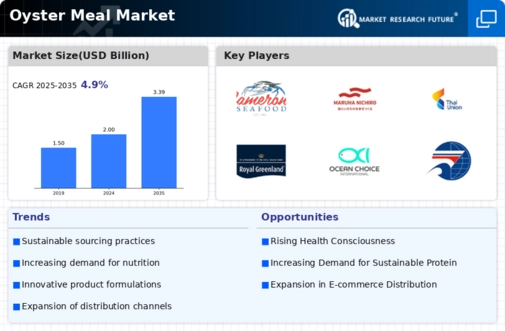Market Growth Projections
The Global Oyster Meal Market Industry is poised for substantial growth in the coming years. With a projected market value of 2 USD Billion in 2024 and an anticipated increase to 3.39 USD Billion by 2035, the industry is on a promising trajectory. The compound annual growth rate (CAGR) of 4.91% from 2025 to 2035 indicates a robust expansion phase, driven by various factors such as rising demand for sustainable protein sources, growth in aquaculture practices, and innovations in food processing technologies. These projections underscore the potential of the oyster meal market to adapt to changing consumer preferences and industry dynamics.
Growth in Aquaculture Practices
The expansion of aquaculture practices globally is a significant driver for the Global Oyster Meal Market Industry. As the demand for seafood continues to rise, aquaculture provides a viable solution to meet this need while minimizing overfishing. Oyster meal serves as an excellent feed ingredient in aquaculture, promoting healthy growth and enhancing the nutritional profile of farmed fish and shellfish. This trend is expected to contribute to the industry's growth, with projections indicating a market value of 3.39 USD Billion by 2035. The integration of oyster meal in aquaculture feed formulations reflects a strategic approach to sustainable seafood production.
Nutritional Benefits of Oyster Meal
The nutritional profile of oyster meal is a compelling factor driving the Global Oyster Meal Market Industry. Rich in protein, vitamins, and minerals, oyster meal is increasingly recognized for its health benefits, including supporting immune function and promoting overall well-being. As health trends evolve, consumers and manufacturers alike are incorporating oyster meal into various food products, including supplements and functional foods. This growing awareness of the health advantages associated with oyster meal is likely to propel market growth, with a compound annual growth rate (CAGR) of 4.91% anticipated from 2025 to 2035. The focus on nutrition aligns with broader dietary trends favoring nutrient-dense foods.
Expanding Applications in Pet Food Industry
The pet food industry is emerging as a significant driver for the Global Oyster Meal Market Industry. With pet owners increasingly prioritizing high-quality, nutritious ingredients for their pets, oyster meal is gaining traction as a valuable protein source in pet food formulations. Its rich nutrient profile supports pet health and wellness, making it an attractive option for manufacturers. As the pet food market continues to expand, the demand for oyster meal is expected to rise correspondingly. This trend reflects a broader movement towards premium pet food products, further solidifying the role of oyster meal in the evolving landscape of pet nutrition.
Innovations in Food Processing Technologies
Advancements in food processing technologies are playing a crucial role in shaping the Global Oyster Meal Market Industry. Innovative techniques for extracting and processing oyster meal enhance its quality and shelf life, making it more appealing to manufacturers and consumers. These technological improvements facilitate the incorporation of oyster meal into a wider range of products, from pet foods to human dietary supplements. As processing methods evolve, the market is likely to see increased adoption of oyster meal, contributing to its projected growth. The continuous development of processing technologies aligns with the industry's goal of maximizing the nutritional benefits of oyster meal.
Rising Demand for Sustainable Protein Sources
The Global Oyster Meal Market Industry is experiencing a notable increase in demand for sustainable protein sources. As consumers become more health-conscious and environmentally aware, they are seeking alternatives to traditional meat products. Oyster meal, derived from the processing of oysters, offers a rich source of protein and essential nutrients while being less resource-intensive compared to land-based livestock. This shift in consumer preferences is projected to drive the market's growth, with the industry expected to reach 2 USD Billion in 2024. The emphasis on sustainability aligns with global trends towards eco-friendly food production, further enhancing the appeal of oyster meal.





















Leave a Comment